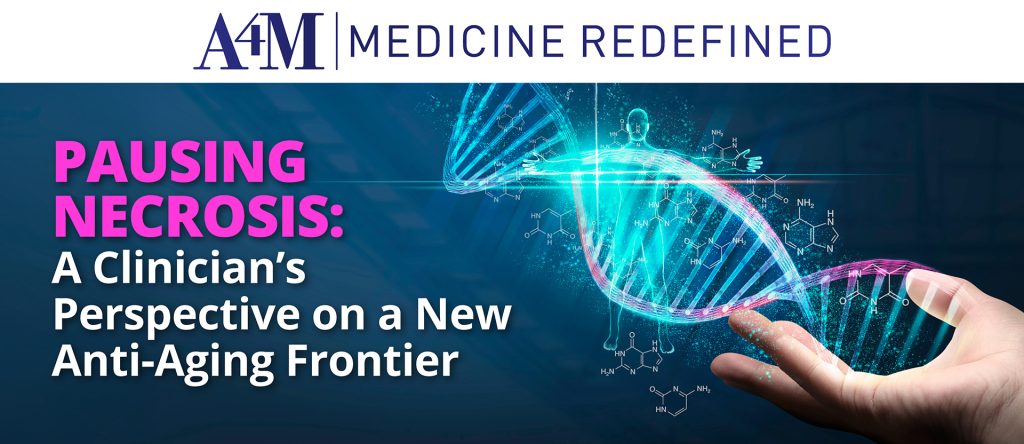Emerging research on necrosis as a therapeutic target marks a pivotal shift in the field of longevity medicine. Historically considered a passive byproduct of tissue injury, necrosis is now being recharacterized as a proactive driver of systemic aging and chronic disease.
This paradigm shift holds clinical implications across specialties, from nephrology and neurology to cardiovascular and regenerative medicine, suggesting that early intervention at the cellular death cascade could preserve organ function, limit fibrosis, and potentially delay biologic aging.
Necrosis as a Core Pathogenic Mechanism
Necrosis is distinguished by uncontrolled cell membrane rupture and the release of intracellular components into the extracellular space, triggering inflammatory and fibrotic responses. Unlike apoptosis, necrosis activates immune effector recruitment through damage-associated molecular patterns (DAMPs) such as HMGB1, ATP, and mitochondrial DNA.
A recent study conducted in Oncogene by UCL and LinkGevity researchers highlights calcium overload as a central initiator of necrotic collapse, resulting in widespread cytosolic damage and immune amplification.
This damage model provides a compelling mechanistic basis for chronic inflammatory pathologies, including ischemic cardiomyopathy, neurodegeneration, and fibrotic kidney disease – conditions all marked by unresolved cycles of immune-mediated injury.
Immune Amplification and Chronic Pathology
Clinically, necrosis contributes to tissue aging by disrupting homeostatic repair processes. Persistent DAMP signaling drives monocyte and macrophage infiltration, promoting fibrotic remodeling and telomere attrition. In the brain, upregulation of RIPK1/RIPK3/MLKL signaling in microglia has been implicated in neurodegenerative cascades, including Alzheimer’s pathology and age-related cognitive decline (Fricker et al., 2018).
Meanwhile, in renal systems, acute tubular necrosis frequently precedes overt drops in GFR, particularly in diabetic or hypertensive patients, populations already vulnerable to accelerated cellular senescence.
The clinical presentation is often subclinical or episodic, complicating early diagnosis and enabling silent progression until irreversible structural damage manifests. That makes necrosis not just a biological signal, but a missed clinical opportunity.
Biomarkers and Diagnostic Integration
The first step toward modulating necrosis is the ability to detect it. Candidate biomarkers include circulating HMGB1, mitochondrial DNA, and elevated plasma LDH levels, which correlate with cell rupture and inflammation. Cytokines like IL-1β, TNF-α, and CXCL8 may further stratify necrotic burden, while necroptosis-specific proteins (e.g., phosphorylated MLKL) are showing promise in both serum and tissue assays (Zhou & Yuan, 2014).
While many of these biomarkers are currently validated in research settings, clinicians can begin by incorporating DAMP screening into risk assessments for patients with chronic inflammation, recurrent ischemia, or impaired wound healing. In the future, advanced imaging agents that selectively bind necrosomes, such as PET tracers targeting MLKL or RIPK3, may allow clinicians to map necrotic hotspots in vivo before gross tissue damage occurs.
Therapeutic Advances: Anti-Necrotic™ Platforms
LinkGevity’s Anti-Necrotic™ platform is developing small molecules designed to prevent calcium-mediated mitochondrial failure and stabilize cell membranes during early necrotic insult. Originally modeled for astronauts who suffer accelerated tissue breakdown under microgravity stress, the compounds are now advancing to terrestrial Phase 2 trials targeting acute tubular necrosis and ischemic injury.
These therapeutics represent not just organ-protective agents but potentially longevity-enhancing interventions. Their dual applicability across acute care, chronic disease management, and aging mitigation points to a broad clinical future, especially in settings where mitochondrial instability and perfusion deficits are at play.
Operationalizing Necrosis Modulation in Practice
For clinicians, the path forward involves integrating necrosis risk management into the broader preventive care model. That means establishing screening intervals for high-risk populations, incorporating biomarkers into annual panels, and collaborating with data scientists to monitor trends across time.
AI-enabled dashboards could eventually automate alerts for early necrotic stress, flagging declines in renal perfusion, abnormal cytokine ratios, or subclinical cardiovascular strain. Protocols would need to define when to escalate from monitoring to treatment, with clear thresholds based on biomarker velocity, not just absolute values.
A multi-disciplinary team structure is essential: physicians will need to work alongside clinical researchers, lab directors, and even regulatory advisors to ensure biomarker interpretation aligns with evidence, liability protections, and patient-centered communication.
Conclusion: Toward a More Proactive Model of Aging Care
Interrupting necrosis as a routine part of medical care reframes longevity medicine from an outcomes-based discipline to a process-driven one. The opportunity is not just to treat disease earlier, but to preserve organ resilience before dysfunction occurs.
For clinicians, necrosis represents a powerful new lever to modulate aging trajectories and extend healthspan through precise, proactive care. By integrating biomarker-based surveillance and therapeutic innovation, we stand at the threshold of a new era in cellular medicine. One that defines health not by the absence of disease, but by the preservation of biological integrity.
Sources:
- University College London, “’Pausing’ Cell Death Could Be the Key to Longevity,” SciTechDaily, 2025
- Fricker et al., “Necroptosis contributes to age-associated neuroinflammation,” Journal of Neuroscience, 2018
- Zhou & Yuan, “Necroptosis in health and diseases,” Nature Reviews Immunology, 2014
- LinkGevity Anti-Necrotic Platform Announcement, Technology Networks, 2024
- LinkGevity Selected by KQ Labs, GlobeNewswire, 2023

